Growing a hanging strawberry plant can be both rewarding and space-efficient. This comprehensive guide will show you how to navigate the unique challenges of vertical gardening, from selecting the right strawberry varieties to the essential care and upkeep. Learn how to create and maintain a productive hanging strawberry garden, even if you’re working with limited space.
Table of Contents
Quick Tips
- Start your hanging strawberry garden by choosing the right variety, considering factors like berry size, runner production, and whether you want a continuous harvest or a large, once-a-year yield.
- Gather all the supplies you need, including suitable baskets, the right potting mix, fertilizers, and watering tools, to ensure your hanging strawberries have the best environment to thrive.
- Maintain your strawberry oasis by consistent watering, appropriate fertilization, pest management, and seasonal pruning. Also, don’t forget to position your baskets to maximize sunlight exposure and prepare your plants for overwintering.
Choosing the Perfect Strawberry Varieties for Hanging Baskets
The secret recipe for a thriving hanging strawberry oasis begins with choosing the right strawberry varieties. You’d want to opt for types that produce small berries and aren’t prone to creating too many runners, which helps maintain a compact growth necessary for limited spaces. Loran strawberries, for instance, are recommended for hanging baskets as they have fewer runners and can be planted closely together, contributing to abundant fruit production.
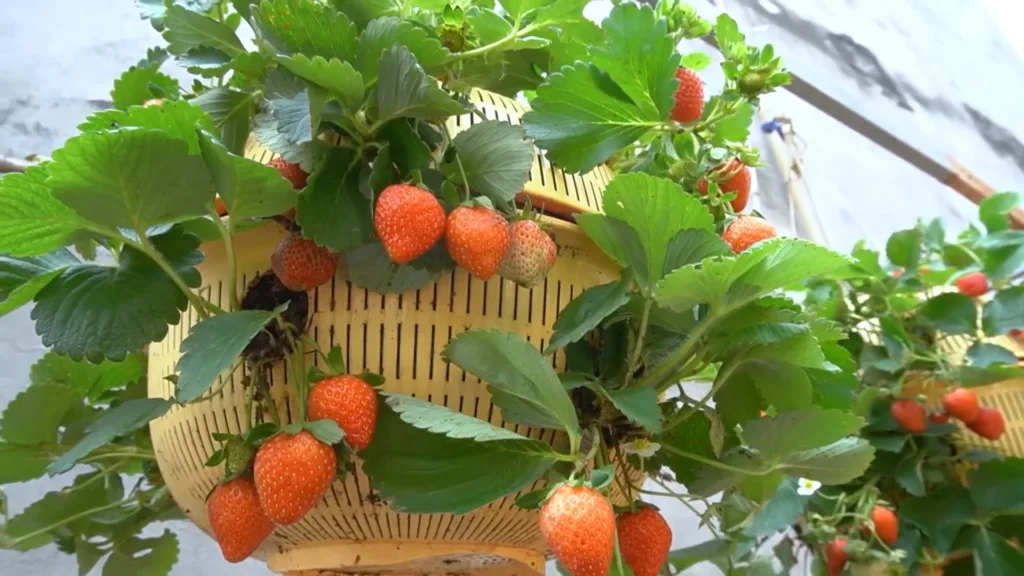
Alpine Strawberries
Alpine strawberries, with their fewer runners and ability to produce fruit even in partial shade, are a great candidate for a hanging basket. Some recommended varieties for hanging baskets are:
- ‘Mignonette’: This variety doesn’t produce runners, minimizing maintenance efforts.
- ‘Alpine Alexandria’: This variety has continuous berry production.
- ‘Ruby Ann’: This variety has striking dark-red fruits and blossoms.
- ‘Alpine Yellow Wonder’ and ‘Alpine White Soul’: These varieties have unique coloring that serves as a natural deterrent to birds.
Day Neutral Varieties
If you fancy a stream of berries throughout the year, day-neutral strawberry varieties are your best bet. Known as ‘ever-bearers’, these varieties can produce fruit, including produce berries, multiple times throughout the year, making them a delightful addition to any hanging strawberry garden.
June Bearing Strawberries
For those who prefer a large, single crop of fruit per year, June Bearing strawberries are the way to go. Over a three-week period in June, these plants shower you with large, flavorful berries that are a treat for the taste buds. Just remember, these plants crave full sun, meaning at least six to eight hours of direct sunlight per day, and slightly acidic soil with a pH between 5.5 and 6.8 for optimum growth and fruit production.
And don’t forget to provide them with winter protection after the early summer June harvest to ensure healthy plants for the next year.
Essential Supplies for a Successful Hanging Strawberry Garden
Now that we’ve got the right strawberry varieties sorted, let’s gear up with the essential supplies. From selecting the right basket to choosing the ideal potting mix and fertilizer, every little detail plays a role in bringing your hanging strawberry garden to life. And yes, let’s not forget about the watering tools and accessories! Here are some essential supplies you’ll need:
- Hanging baskets or containers
- Potting mix
- Fertilizer
- Watering can or hose
- Watering accessories (e.g. spray nozzle, watering wand)
Make sure to gather all these supplies before you start planting your hanging strawberries garden to grow strawberries and eventually harvest strawberries.
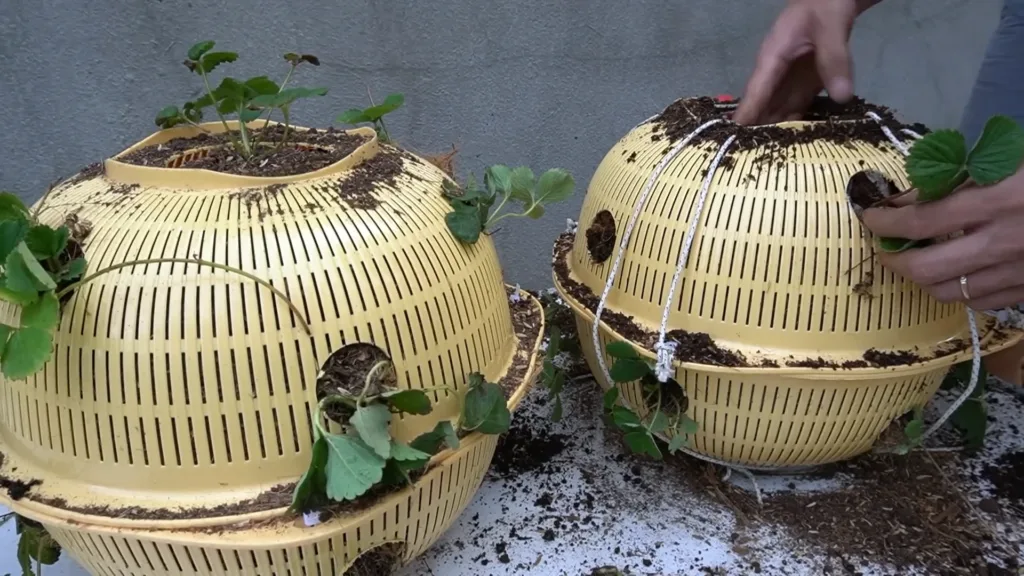
Basket Selection
The right basket material can make a world of difference to the health and productivity of your strawberry plants. Here are some key considerations:
- Plastic pots are preferred as they retain moisture better than terra cotta pots and are less likely to break when dropped.
- The basket should have a minimum diameter of 25cm to provide enough space for the plants to grow.
- The basket should feature good water drainage to prevent waterlogging.
In fact, a 35cm basket can support up to four strawberry plants, allowing for optimal growth and fruit production.
Potting Mix and Fertilizer
The potting mix is like the bed where your strawberry plants sleep. Therefore, it needs to be comfortable and nutritious. A potting mix designed specifically for containers with ingredients such as all-purpose potting mix or multipurpose compost is crucial as strawberries need slightly acidic, humus-rich, and nutrient-rich soil.
Incorporating perlite, like in Burpee Organic Potting Mix, improves the drainage, essential for strawberry plants grown in containers. And let’s not forget the slow-release fertilizer, which gives your plants the food they need to grow and bear delicious berries.
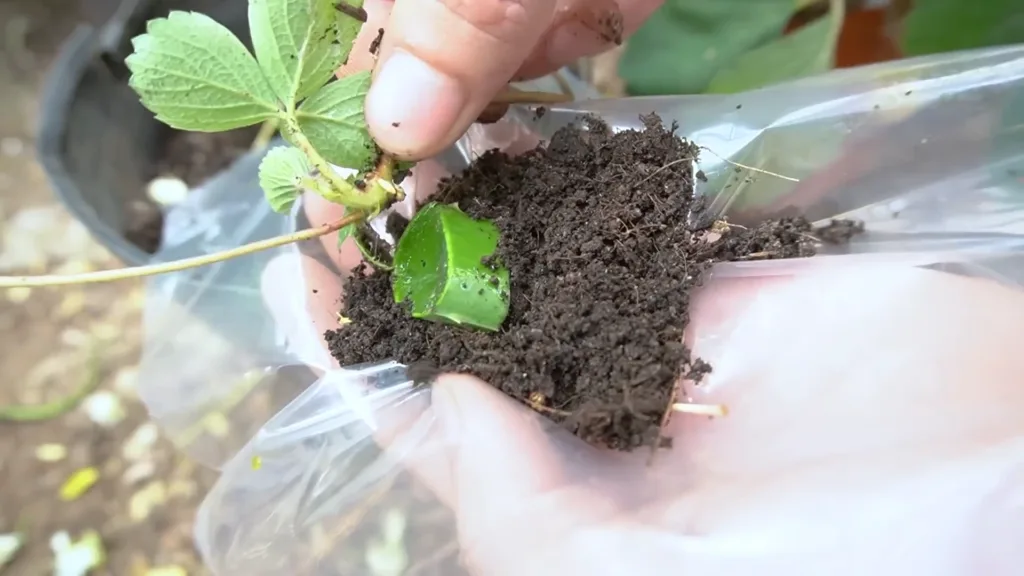
Watering Tools and Accessories
Just as we humans need water to stay hydrated, so do the strawberry plants. Keeping the consistency in moisture levels is where self-watering hanging baskets come in handy, reducing the need for frequent manual watering.
And for those times when manual watering is needed, an extended sprayer wand can make it more efficient and accurate.
Planting Your Hanging Strawberry Baskets: Step-by-Step Guide
With the right varieties and supplies in place, it’s time to roll up your sleeves and get to planting. The best time to plant garden-ready strawberry plants in hanging baskets is early to mid-spring.
Let’s break down the process into simple, manageable steps.
Preparing the Basket
The first step is to prepare your basket. Here’s how:
- Line it with coconut coir or peat moss. This not only maintains moisture but also creates a stable environment for the strawberry roots.
- Ensure proper drainage by making sure the basket has good-sized drainage holes.
- If necessary, add a layer of gravel at the bottom to further improve drainage.
Planting the Strawberry Plants
Next comes the planting. You can house two to three strawberry plants in a 12 to 14-inch diameter hanging pot or basket. Make sure to cover the roots adequately with soil, while positioning the crowns just above the soil level.
Planting the strawberries close together enhances pollination and increases fruit production. And remember, proper plant placement is crucial for providing sufficient air circulation and sunlight, both essential for healthy growth and fruiting.
Finalizing the Setup
After planting, give your strawberries a thorough watering to help them settle into their new home. This ensures all air pockets are removed, providing a stable foundation for the strawberry plants.
To maintain your hanging strawberry oasis, remember to replace the strawberry plants every three years due to natural declines in flowering and fruit production over time.
Maintaining Your Hanging Strawberry Oasis
Now that the strawberries are all planted and settled, it’s time to talk about maintenance. From watering to fertilization to pest control, let’s delve into the essential steps to ensure your hanging strawberry oasis stays lush and fruitful.
Watering Guidelines
When it comes to watering, consistency is key. Ensure your strawberry plants have enough moisture to produce high-quality berries, especially during hot spells and the fruiting period. Aim to keep the soil evenly moist but not waterlogged. Check the top 1-2 inches of soil in the hanging baskets; if they feel dry, it’s time to water.
Also, remember to water the plants at the soil level to keep the foliage dry and prevent disease. And in warmer climates or particularly hot weather, you might need to water every 1-2 days to prevent the plants from drying out.
Fertilization and Soil Maintenance
Strawberries are not heavy feeders and benefit more from mid-season additions of aged manure or compost rather than frequent fertilization. For optimal growth and fruit production, use organic liquid fertilizers or slow-release fertilizers, which provide a balanced nutrient ratio. Fertilizers formulated for tomatoes, fruits, and vegetables, rich in potassium and low in nitrogen, are preferred for strawberry plants to encourage better fruit production.
Start feeding the plants after the onset of flowering, and include consistent watering and monthly fertilization with a potassium-rich, low-nitrogen liquid fertilizer.
Pest Control and Prevention
One of the perks of growing strawberries in hanging baskets is that it keeps the strawberries out of reach of many insects and wildlife. However, pests like spittlebugs and tarnished plant bugs can still be a nuisance. These can be dealt with by using a strong stream of water, white sticky traps, and insecticidal soap.
Also, watering the baskets less frequently but more deeply can reduce the risk of soil borne diseases and a slug infestation, as slugs are attracted to constantly wet soil. You can also deter slugs by sprinkling diatomaceous earth around the base of the plants.
Maximizing Fruit Production in Hanging Baskets
Now, let’s talk about the star of the show – the fruit! To maximize fruit production, there are certain techniques and tips we can employ. From pruning to pollination to sunlight requirements, let’s explore how to get a bumper harvest from your hanging strawberry baskets.
Pruning Techniques
Pruning is an essential part of strawberry plant care. After the final harvest of the season, prune the plants by removing all shoots that have produced fruit in the past year, ensuring the removal of brown, yellow, dry, and diseased leaves and parts. Regularly trimming off such leaves and parts can help maintain the health and productivity of the plants.
Removing runners, or long stems that grow out of the base of the plant, can help the plant focus its energy on fruit production, enhancing the overall yield.
Pollination Tips
Pollination is crucial for the production of fruits. Attracting pollinators like bees is vital for the pollination process in strawberry plants.
You can enhance pollination by positioning hanging strawberry plants closer together to more effectively attract bees.
Sunlight Requirements
Sunlight plays a crucial role in the fruit production of strawberry plants. For optimal fruit production, your hanging baskets need to receive six to eight hours of full sun daily. While general sunlight requirement for strawberry plants is significant, some Alpine varieties can manage with a bit more shade.
Just remember to place the basket in a location shielded from strong winds yet still receiving the full amount of required daily sunlight.
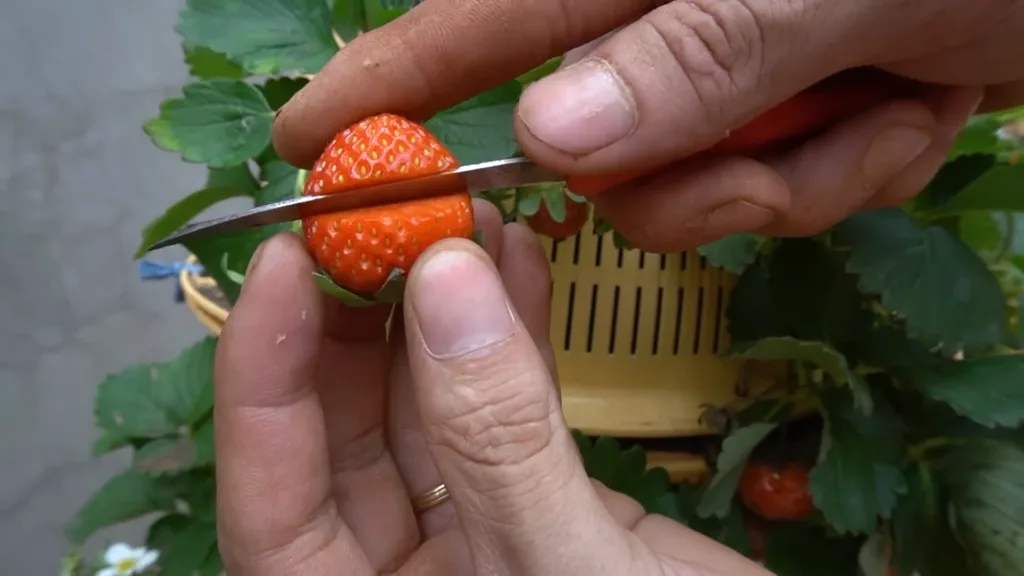
Overwintering and Preparing for the Next Growing Season
Strawberries might be a summer fruit, but that doesn’t mean we forget about them in winter. Proper winter care and preparation for the next growing season can allow your strawberry plants to thrive for three to five years.
Let’s take a look at how to overwinter your hanging strawberry plants and prepare them for the next growing season.
Winter Protection
Before the first frost, it’s important to move your hanging strawberry baskets indoors to protect them from the cold. Once indoors, the plants should be watered sparingly to avoid the root ball drying out. The ideal indoor location for overwintering strawberry plants is bright and cool.
During extreme weather conditions, move the baskets to a sheltered area for additional protection.
Spring Preparation and Revitalization
Come spring, it’s time to wake up your strawberry plants and prepare them for the new growing season. Repot each plant using fresh soil to rejuvenate them and invigorate their root systems.
This annual springtime routine can lead to enhanced productivity from the strawberry plants for up to three years.
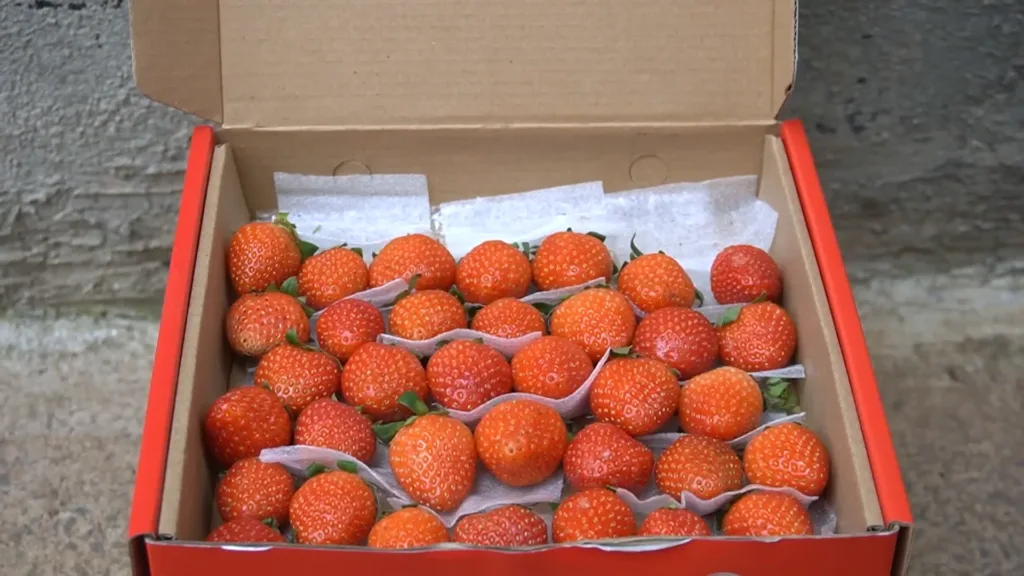
Final Thoughts
Growing your own hanging strawberry oasis might seem like a challenge, but with the right varieties, supplies, and care, it’s a rewarding endeavor. From choosing the right strawberry varieties and essential supplies to planting, maintaining, and maximizing fruit production, every step brings you closer to a lush, red cascade of strawberries. And remember, your efforts don’t stop at the end of summer – proper winter care and spring preparation can ensure your strawberry plants return, year after year, to provide you with a delightful harvest. So, are you ready to create your own hanging strawberry oasis?
Answers to Common Queries
What are the best strawberry varieties for hanging baskets?
For hanging baskets, consider planting Alpine strawberries or day-neutral varieties for compact growth and continuous fruit production. Happy gardening!
How to prepare the basket for planting strawberries?
To prepare the basket for planting strawberries, line it with coconut coir or peat moss, ensure it has drainage holes, and consider adding a layer of gravel at the bottom if needed. Happy planting!
How often should you water hanging strawberry plants?
Water your hanging strawberry plants regularly, especially during hot spells and the fruiting period, to keep the soil evenly moist but not waterlogged.
How can you maximize fruit production in hanging baskets?
To maximize fruit production in hanging baskets, you should use pruning techniques, enhance pollination, and ensure ample sunlight. These are the key factors for success!
How to overwinter hanging strawberry plants?
To overwinter hanging strawberry plants, bring the baskets inside before the first frost, place them in a bright, cool spot, and water them sparingly. It’s important to give them extra protection during harsh weather.

Leave a Comment